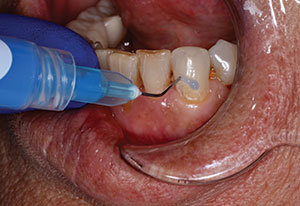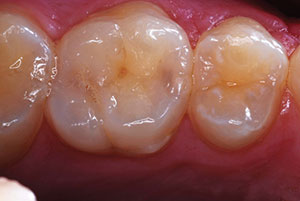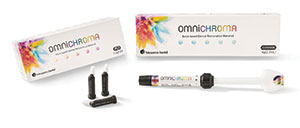The evolution in composite resin technology has evidenced numerous improvements over the last half-century through alterations in the resin and filler chemistries. However, the most significant developments for improvement in mechanical and clinical success were achieved from altering the filler composition, particle size, distribution, and quantity incorporated. The chemistry for the organic matrix phase has remained essentially the same since the introduction of the first resin system by Rafael Bowen in the 1950s. In general, most of these composite resin systems utilize a mixture of dimethacrylates such as Bis-GMA/TEGDMA, or urethane dimethacrylate (UDMA).
CORRECTING THE WEAK LINK
The matrix phase has been considered the weak link of the composite resin system. Since polymerization shrinkage has been an intrinsic characteristic of the matrix phase, it has been the strategy of material scientists to minimize this phase of the methacrylate mixture, thereby resulting in more desirable clinical properties. Currently, an important area of research is the development of new resin monomer technology. These developments have indicated that a change in monomer chemistry and its relationship to the filler may be the solution to polymerization shrinkage and clinical challenges (ie, shrinkage stress) that are associated with these methacrylate-based composite resin systems. Two recently developed composite-resin systems have replaced the weak link—the matrix. A comparison of the new matrix chemistries of both systems can provide the attributes and capabilities for their clinical applications.
SILORANE CHEMISTRY
The Filtek LS Low Shrink Posterior Restorative resin (3M ESPE) is based on silorane chemistry and does not contain methacrylates. Siloranes are a completely new type of compounds for the use in dentistry. The name silorane is derived from its chemical building blocks siloxanes and oxiranes. The siloxanes are known for their hydrophobicity, while the oxirane polymers are known for their low shrinkage and superior stability toward many physical/chemophysical forces and influences. The combination of the 2 molecular building blocks provides a biocompatible, hydrophobic, and low-shrinking silorane monomer.
According to Buergers, et al, the increased hydrophobicity of the silorane-based composites may be responsible for a low adhesion potential of the resin to streptococci strains and may potentially increase the longevity of direct fillings and reduce recurrent caries (Buergers, et al, 2009). The polymerization process occurs by way of a cationic ring-opening reaction that results in a lower polymerization contraction, when compared to the methacrylate-based resins which polymerize via a radical-addition reaction of their double bonds. The ring-opening step in the polymerization of the silorane resin significantly reduces the amount of polymerization shrinkage that occurs during the curing process. In contrast to the linear-reactive groups of methacrylates, the ring-opening chemistry of the siloranes initiates with the cleavage and opening of the ring systems. This process gains space and counteracts the loss of volume, which occurs in the subsequent step, when the chemical bonds are formed. Therefore, the ring-opening polymerization process yields a reduced volumetric shrinkage. Volumetric shrinkage values of 0.66 to 1.0% have been reported depending upon the test method employed. In addition, the surface of the quartz filler particles are modified with a silane layer which was specifically matched to the silorane technology to provide the proper interface of the filler to the resin for improved mechanical properties.
However, one major consideration for the successful use of this silorane system is the necessity of a dedicated adhesive system. A 2-step self-etch adhesive system has been designed to bridge the differences of hydrophilicity and hydrophobicity at the interface between the tooth and the restorative material. Adhesives currently available for traditional methacrylate materials cannot be used in combination with Filtek LS restorative, because they are not compatible and can lead to insufficient clinical results and performance. A one-year clinical study reported that Filtek LS Low Shrink Posterior Restorative System was used in conjunction with its self-etch bonding agent LS System Adhesive (3M ESPE) in restoring 225 teeth in 143 patients. The restorations were evaluated at recall up to one year after placement. All restorations remained intact during this time. Marginal staining was minimal, and no sensitivity was reported with the restorations (Farah JW, Powers JM, eds. Dental Advisor. 2009). The suggested clinical indications for use with this low-shrinkage composite resin system include all posterior restorative applications (ie, Class I, II, III, IV, V, and direct veneers).
URETHANE DIMETHACRYLATE CHEMISTRY
There is a new composite resin system (Kalore [GC America]) that is based on a technology recently developed by Dupont, which utilizes a DX-511 molecule in its matrix. The Dupont molecule, DX-511, is a new monomer family based on urethane dimethacrylate chemistry that is compatible with the current composite and bonding systems. This monomer has a long rigid molecular core and flexible arms in the structure. The long rigid core prevents monomer deformation and reduces polymerization shrinkage. On the other hand, if the molecular core is flexible, the monomer may fold and will occupy less space, causing a loss in dimension. The molecular weight of this monomer is 895 which is twice that of Bis-GMA or UDMA.
Generally, the short chain monomers with lower molecular weight have the greatest polymerization shrinkage and inferior physical characteristics than the long chain monomers. A high molecular weight monomer reduces polymerization shrinkage because it contains only a small number of double bonded C=C, which is a factor in polymerization shrinkage. However, if the monomer chain becomes too long, then reactivity decreases. To overcome this challenge, flexible arms were created on the new Dupont monomer, thus increasing the potential for reactivity. The manufacturer has reported volumetric shrinkage values of 1.72%, claiming that the shrinkage stress values are the lowest of any composite resin system. Furthermore, the interfacial bonding between the inorganic fillers (ie, strontium glass, fluoro alumina silicate glass) and the resin matrix involves a proprietary treatment. This proprietary chemical treatment of the filler surface improves the bond between the filler and matrix phase. The chemical bond allows for a stronger bond between the filler and resin thus increasing surface hardness, wear resistance, and polishability. The suggested clinical indications for use with this low shrinkage composite resin system include all anterior and posterior restorative applications (ie, Class I, II, III, IV, V, and direct veneers).
CLINICAL RAMIFICATIONS OF IMPROVED PHYSICAL PROPERTIES
These new monomer technologies provide low shrinkage and thus the potential for a reduction in shrinkage stress at the restorative-tooth interface. The possible clinical manifestations include the potential for minimizing marginal contraction gaps, microleakage, marginal staining and caries recurrence, while also dissipating and reducing functional stresses across the restorative-tooth interface and improving the natural aesthetics and wear resistance. Although these new biomaterials appear promising, the clinically-well-accepted conventional methacrylate-based composite resin systems have 50 years of proven success and thus future clinical trials will determine the destiny of this new type of composite material.
Suggested Reading
Aesthetic & Restorative Dentistry: Material Selection & Technique. Available at everestpublishingmedia.net.
Dr. Terry is assistant professor in the Department of Restorative Dentistry and Biomaterials at the University of Texas Health Science Center Dental Branch at Houston. He maintains a private practice in Houston. He can be reached at (281) 481-3483 or dterry@dentalinstitute.com.
Disclosure: Dr. Terry reports no conflicts of interest.
Dr. Leinfelder is currently an adjunct professor at the University of North Carolina and professor emeritus at the University of Alabama. He can be reached at (919) 370-9168 or kcullie@aol.com.
Disclosure: Dr. Leinfelder is an unpaid consultant for Pentron Clinical Technologies.
Dr. Blatz is currently professor of Restorative Dentistry and Chairman of the Department of Preventive and Restorative Sciences at the University of Pennsylvania School of Dental Medicine. He can be reached at (215) 573-3959 or via e-mail at mblatz@dental.upenn.edu.
Disclosure: Dr. Blatz receives research grants and support from Nobel Biocare, Straumann, Ivoclar Vivadent, Kurrary, Heraeus Kulzer, DENTSPLY, and 3M ESPE.










